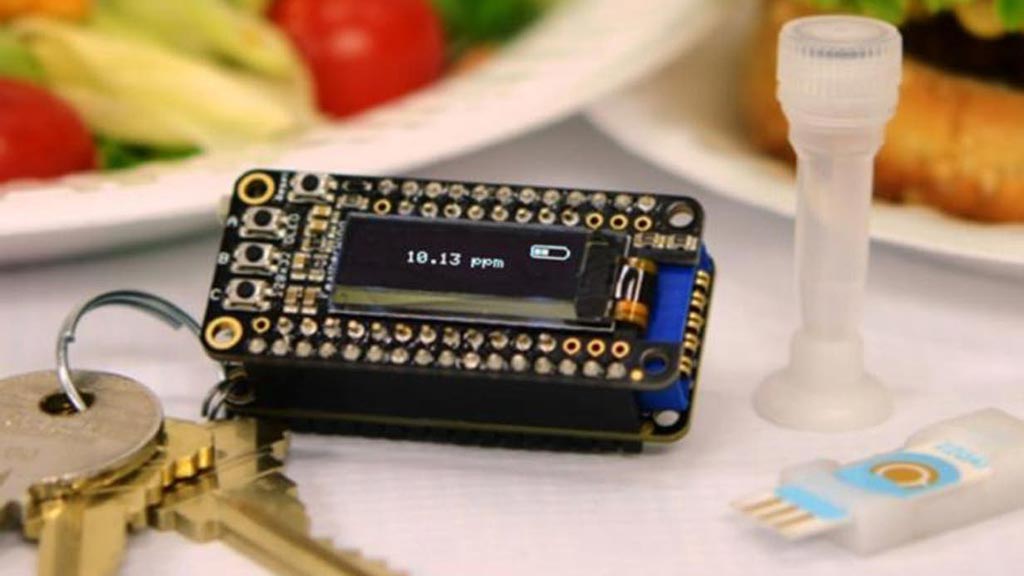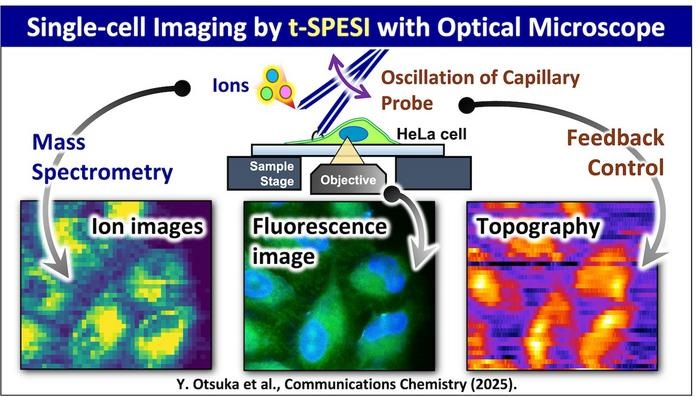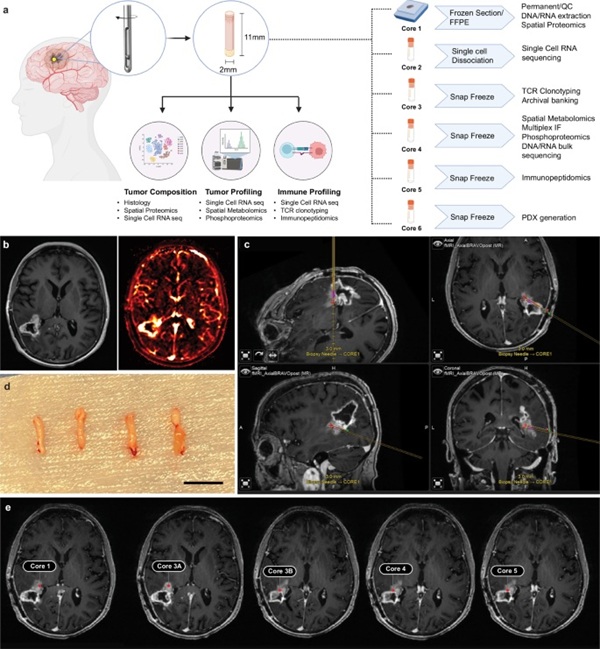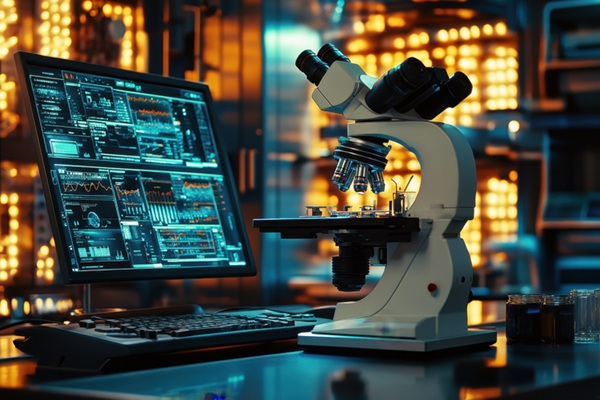Personal Lab Offers Rapid Detection of Food Allergens
|
By LabMedica International staff writers Posted on 06 Nov 2017 |

Image: The iEAT system for onsite antigen detection consists of a pocket-sized detector, an electrode chip, and a disposable kit for allergen extraction. The detector connects with a smartphone for system control and data upload to a cloud server (Photo courtesy of Lin, et al. ACS Nano, August 2017).
Researchers have developed a small, low cost device for individual use that can accurately detect food allergens in less than ten minutes.
Adverse food reactions, including food allergies, food sensitivities, and autoimmune reaction (e.g., celiac disease) affect 5-15% of the population of the USA and remain a considerable public health problem requiring stringent food avoidance and epinephrine availability for emergency events. Avoiding problematic foods is difficult in practical terms, given current reliance on prepared foods and out-of-home meals.
In response to the food allergy problem, investigators at Harvard Medical School (Boston, MA, USA) developed a portable, point-of-use detection technology, that they called "integrated exogenous antigen testing" (iEAT).
The iEAT device consists of three components: (1) a small plastic test tube, (2) a small electronic detection module, and (3) the electronic keychain reader. To perform the test, the user dissolves a small sample of the food in the plastic test tube and then adds magnetic beads that capture the food allergen of interest. A bit of this mixture is loaded onto electrode strips attached to a small module that is then inserted into the electronic keychain reader. The keychain reader has a small display that indicates whether the allergen is present, and if so, in what concentration.
The prototype iEAT system was optimized to detect five major food antigens in peanuts, hazelnuts, wheat, milk, and eggs. Antigen extraction and detection with iEAT required less than 10 minutes and achieved high-detection sensitivities (e.g., 0.1 milligram per kilogram for gluten, 200 times lower than regulatory limits of 20 milligram per kilogram).
The investigators also developed a dedicated cell phone application, which allows the user to compile and store the data collected by testing different foods for various allergens at different restaurants or in packaged foods. The application is set up to share this information online with both time and location stamps indicating when, where, and in what food or dish an allergen reading was taken.
“High accuracy built into a compact system was the key goals of the project,” said contributing author Dr. Ralph Weissleder, professor of radiology and systems biology at Harvard Medical School. “Users can be confident that even if they are sensitive to very low levels, iEAT will be able to give them exact concentrations. Armed with accurate concentration levels they will not have to completely avoid potentially problematic foods, but will know whether an allergen is at a dangerous level for them or a concentration that is safe for them to eat.”
The iEAT device was described in the August 2017 issue of the journal ACS Nano.
Related Links:
Harvard Medical School
Adverse food reactions, including food allergies, food sensitivities, and autoimmune reaction (e.g., celiac disease) affect 5-15% of the population of the USA and remain a considerable public health problem requiring stringent food avoidance and epinephrine availability for emergency events. Avoiding problematic foods is difficult in practical terms, given current reliance on prepared foods and out-of-home meals.
In response to the food allergy problem, investigators at Harvard Medical School (Boston, MA, USA) developed a portable, point-of-use detection technology, that they called "integrated exogenous antigen testing" (iEAT).
The iEAT device consists of three components: (1) a small plastic test tube, (2) a small electronic detection module, and (3) the electronic keychain reader. To perform the test, the user dissolves a small sample of the food in the plastic test tube and then adds magnetic beads that capture the food allergen of interest. A bit of this mixture is loaded onto electrode strips attached to a small module that is then inserted into the electronic keychain reader. The keychain reader has a small display that indicates whether the allergen is present, and if so, in what concentration.
The prototype iEAT system was optimized to detect five major food antigens in peanuts, hazelnuts, wheat, milk, and eggs. Antigen extraction and detection with iEAT required less than 10 minutes and achieved high-detection sensitivities (e.g., 0.1 milligram per kilogram for gluten, 200 times lower than regulatory limits of 20 milligram per kilogram).
The investigators also developed a dedicated cell phone application, which allows the user to compile and store the data collected by testing different foods for various allergens at different restaurants or in packaged foods. The application is set up to share this information online with both time and location stamps indicating when, where, and in what food or dish an allergen reading was taken.
“High accuracy built into a compact system was the key goals of the project,” said contributing author Dr. Ralph Weissleder, professor of radiology and systems biology at Harvard Medical School. “Users can be confident that even if they are sensitive to very low levels, iEAT will be able to give them exact concentrations. Armed with accurate concentration levels they will not have to completely avoid potentially problematic foods, but will know whether an allergen is at a dangerous level for them or a concentration that is safe for them to eat.”
The iEAT device was described in the August 2017 issue of the journal ACS Nano.
Related Links:
Harvard Medical School
Latest Molecular Diagnostics News
- POC Diagnostic Platform Combines Immunoassay and Molecular Testing
- Innovative Test Accurately Evaluates Liver Fibrosis Severity in Just 18 Minutes
- Single Blood Test Could Detect Different Types of Cancer at Early Stages
- POC Oral Swab Test to Increase Chances of Pregnancy in IVF
- Microbial Cell-Free DNA Test Accurately Identifies Pathogens Causing Pneumonia and Other Lung Infections
- Non-Biopsy Approach to Transform Adult Celiac Disease Diagnoses
- Groundbreaking Molecular Diagnostic Test Accurately Diagnoses Major Genetic Cause of COPD
- First-in-Class Diagnostic Blood Test Detects Axial Spondyloarthritis
- New Molecular Label to Help Develop Simpler and Faster Tuberculosis Tests
- Biomarker Discovery Paves Way for Blood Tests to Detect and Treat Osteoarthritis
- Liquid Biopsy Assay Detects Recurrence in CRC Patients Prior to Imaging
- Ultra Fast Synovial Fluid Test Diagnoses Osteoarthritis and Rheumatoid Arthritis In 10 Minutes
- Genetic-Based Tool Predicts Survival Outcomes of Pancreatic Cancer Patients
- Urine Test Diagnoses Early-Stage Prostate Cancer
- New Genetic Tool Analyzes Umbilical Cord Blood to Predict Future Disease
- Spinal Fluid Biomarker for Parkinson’s Disease Offers Early and Accurate Diagnosis
Channels
Clinical Chemistry
view channel
AI-Powered Blood Test Accurately Detects Ovarian Cancer
Ovarian cancer ranks as the fifth leading cause of cancer-related deaths in women, largely due to late-stage diagnoses. Although over 90% of women exhibit symptoms in Stage I, only 20% are diagnosed in... Read more
Automated Decentralized cfDNA NGS Assay Identifies Alterations in Advanced Solid Tumors
Current circulating cell-free DNA (cfDNA) assays are typically centralized, requiring specialized handling and transportation of samples. Introducing a flexible, decentralized sequencing system at the... Read more
Mass Spectrometry Detects Bacteria Without Time-Consuming Isolation and Multiplication
Speed and accuracy are essential when diagnosing diseases. Traditionally, diagnosing bacterial infections involves the labor-intensive process of isolating pathogens and cultivating bacterial cultures,... Read more
First Comprehensive Syphilis Test to Definitively Diagnose Active Infection In 10 Minutes
In the United States, syphilis cases have surged by nearly 80% from 2018 to 2023, with 209,253 cases recorded in the most recent year of data. Syphilis, which can be transmitted sexually or from mother... Read moreHematology
view channel
First Point-of-Care Heparin Monitoring Test Provides Results in Under 15 Minutes
Heparin dosing requires careful management to avoid both bleeding and clotting complications. In high-risk situations like extracorporeal membrane oxygenation (ECMO), mortality rates can reach about 50%,... Read more
New Scoring System Predicts Risk of Developing Cancer from Common Blood Disorder
Clonal cytopenia of undetermined significance (CCUS) is a blood disorder commonly found in older adults, characterized by mutations in blood cells and a low blood count, but without any obvious cause or... Read moreImmunology
view channel
Stem Cell Test Predicts Treatment Outcome for Patients with Platinum-Resistant Ovarian Cancer
Epithelial ovarian cancer frequently responds to chemotherapy initially, but eventually, the tumor develops resistance to the therapy, leading to regrowth. This resistance is partially due to the activation... Read more
Machine Learning-Enabled Blood Test Predicts Immunotherapy Response in Lymphoma Patients
Chimeric antigen receptor (CAR) T-cell therapy has emerged as one of the most promising recent developments in the treatment of blood cancers. However, over half of non-Hodgkin lymphoma (NHL) patients... Read moreMicrobiology
view channel
New Blood Test Detects Up to Five Infectious Diseases at POC
Researchers have developed a prototype flow-through assay capable of detecting up to five different infections, with results that can be quickly analyzed and transmitted via a specialized smartphone app.... Read more
Molecular Stool Test Shows Potential for Diagnosing TB in Adults with HIV
Tuberculosis (TB), caused by the bacterium Mycobacterium tuberculosis, led to 1.25 million deaths in 2023, with 13% of those occurring in people living with HIV. The current primary diagnostic method for... Read morePathology
view channel
New Technology Improves Understanding of Complex Biological Samples
Tissues are composed of a complex mixture of various cell types, which complicates our understanding of their biological roles and the study of diseases. Now, a multi-institutional team of researchers... Read more
Combining Multiple Laboratory Techniques Provides Deeper Insights into Deadly Brain Tumors
Glioblastoma (GBM) is a highly aggressive primary brain cancer that currently has limited effective treatments. Stereotactic needle biopsies are commonly employed for diagnosis; however, their use is restricted... Read more
AI-Based Diagnosis System Identifies Malaria Parasites from Blood Smear Images
Malaria diagnosis has traditionally been performed manually via microscopic examination, a process that is not only time-consuming but also highly dependent on the expertise and accuracy of healthcare providers.... Read moreTechnology
view channel
Advanced Predictive Algorithms Identify Patients Having Undiagnosed Cancer
Two newly developed advanced predictive algorithms leverage a person’s health conditions and basic blood test results to accurately predict the likelihood of having an undiagnosed cancer, including ch... Read more
Light Signature Algorithm to Enable Faster and More Precise Medical Diagnoses
Every material or molecule interacts with light in a unique way, creating a distinct pattern, much like a fingerprint. Optical spectroscopy, which involves shining a laser on a material and observing how... Read more
Disposable Microchip Technology Could Selectively Detect HIV in Whole Blood Samples
As of the end of 2023, approximately 40 million people globally were living with HIV, and around 630,000 individuals died from AIDS-related illnesses that same year. Despite a substantial decline in deaths... Read more
Pain-On-A-Chip Microfluidic Device Determines Types of Chronic Pain from Blood Samples
Chronic pain is a widespread condition that remains difficult to manage, and existing clinical methods for its treatment rely largely on self-reporting, which can be subjective and especially problematic... Read moreIndustry
view channel
Qiagen Acquires NGS Analysis Software Company Genoox
QIAGEN (Venlo, the Netherlands) has signed a definitive agreement to acquire Genoox (Tel Aviv, Israel), a provider of artificial intelligence (AI)-powered software that enables clinical labs to scale and... Read more
Cepheid and Oxford Nanopore Technologies Partner on Advancing Automated Sequencing-Based Solutions
Cepheid (Sunnyvale, CA, USA), a leading molecular diagnostics company, and Oxford Nanopore Technologies (Oxford, UK), the company behind a new generation of sequencing-based molecular analysis technologies,... Read more
Grifols and Tecan’s IBL Collaborate on Advanced Biomarker Panels
Grifols (Barcelona, Spain), one of the world’s leading producers of plasma-derived medicines and innovative diagnostic solutions, is expanding its offer in clinical diagnostics through a strategic partnership... Read more

















